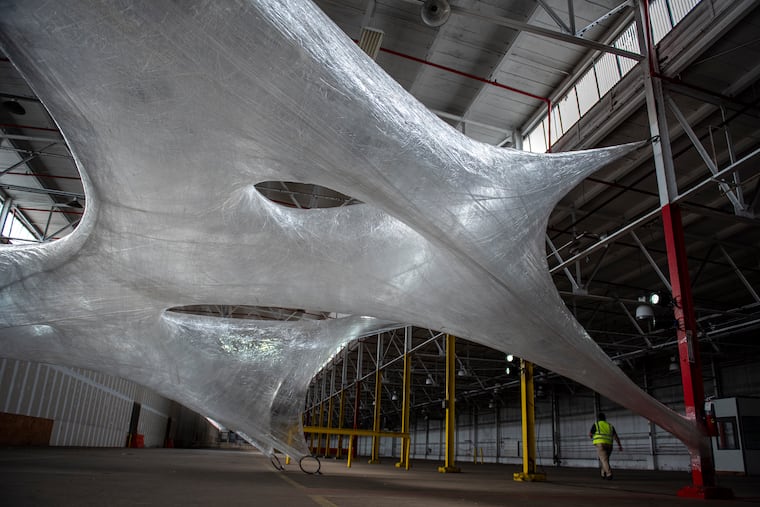The sticky problem with the Navy Yard’s tape ‘Cocoon’ installation | Opinion
Without a deeper message, the Cocoon reads as a tone-deaf illustration of capitalism rather than commentary on it.

Last Saturday, a giant, interactive sculpture made entirely from tape opened at the Navy Yard. Created by the European arts collective Numen/For Use, Tape Philadelphia: Enter the Cocoon is the latest public art installation commissioned by the Navy Yard through the anonymous curators known as Group X. It’s an impressive feat of engineering as well as a visual and experiential spectacle.
Unfortunately, it’s also a spectacle of environmental contamination. It may be fun and beautiful, but the Cocoon’s use of virgin plastic is egregious. It’s less a work of art than it is a shrine to fossil fuels. Such an environmentally hazardous creation has little excuse for existing without some serious self-reflection.
As soon as Group X posted photos of the Cocoon on Instagram, commenters began wondering what would become of the plastic when the installation is removed. The curators’ response was that a reuse plan is in the works. But no matter how many times this tape gets reused, its ultimate destination will be one of three places: a landfill, an incinerator, or the ocean. Those are the only options, and none of them is good.
This is the problem with using 21.5 miles of plastic tape as a medium: Plastic can never truly be recycled. It can only be down-cycled into weaker or otherwise less valuable material. Case in point: Despite years of searching, the artists have been unable to find a recycled tape strong enough to support people crawling around inside the finished piece (a fact I learned when I visited the installation during its press preview).
It’s possible to imagine a world where this sculpture is lauded for calling attention to consumerism. What if it used the same amount of tape Amazon uses in a day? Or the average American uses in a lifetime? Or Philadelphians will wrap their holiday presents with this year? Designing it to represent real-world plastic usage would make for a powerful statement. Climbing inside a physical representation of overconsumption might actually have an impact on participants and their view of plastic.
Even if the artwork did strive to persuade viewers to reduce their plastic consumption, the primary onus to eliminate plastic lies not with individuals but with institutions. What if the Navy Yard had used this installation as a jumping-off point for making environmental commitments on their South Philly campus? Innovative sustainability initiatives — in addition to sculptural pageantry — might attract even more visitors and tenants.
Knowing what we do about the dangers and impacts of plastic, any piece on this scale must be tied to a message about the medium itself. By its very nature, the Navy Yard Cocoon should demonstrate to the viewer that it can exist only as long as we tolerate mindless plastic consumption. Perhaps it should even advocate against its own existence. Without such a message, the Cocoon reads as a tone-deaf illustration of capitalism rather than commentary on it.
Sadly, a statement from Group X makes it clear that there’s no message behind the Cocoon: “Our goal with Group X is to create art that’s accessible to everyone and to create art for art’s sake. Art doesn’t always need to have a history lesson or push a particular agenda.”
It seems the piece is just an empty ploy to grab some attention. That it certainly does — but let’s hope the next installation from Group X and the Navy Yard has matured from the cocoon phase of its life into something a bit more self-aware.
Eric Dale is a designer, photographer, and street-art journalist in Philadelphia.